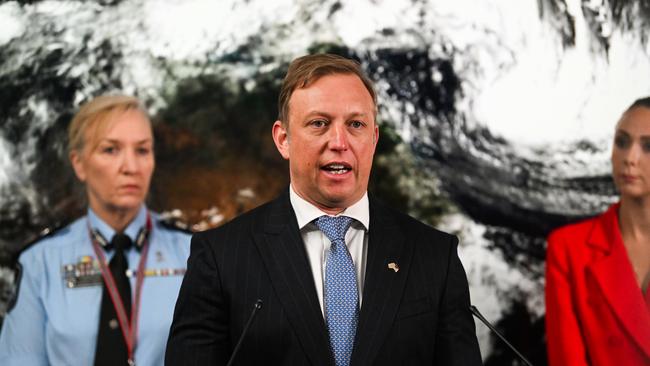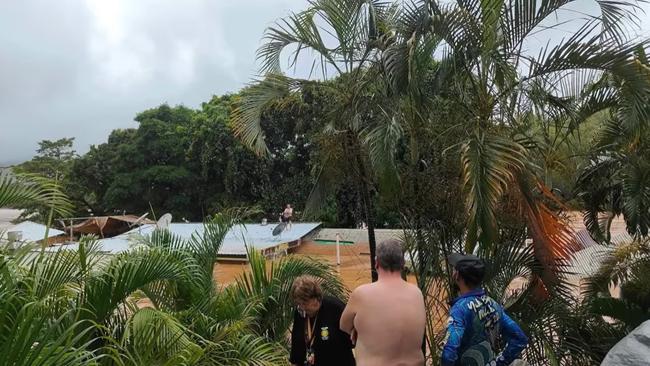Qld weather: Damning disaster communications report exposes how authorities let state down
Jaw-dropping tales of failures in disaster communications – including one in which a stranded group had to phone relatives in Scotland for help – have been laid bare.

QLD News
Don't miss out on the headlines from QLD News. Followed categories will be added to My News.
Jaw-dropping tales of failures in Queensland’s disaster communications – including one incident in which a stranded group had to phone relatives in Scotland for help – have been laid bare in a damning new report, with police now tasked with designing a new statewide training program.
The report by the Office of the Inspector-General of Emergency Management (IGEM) into the 2023-24 severe weather season found “limitations in capacity and capability” in the state’s ability to respond to disaster events, with local councils reporting poor co-ordination between local, state, and federal agencies that left Queenslanders without clear leadership.
In the wake of Annastacia Palaszczuk’s abrupt departure in December 2023, incoming then-Premier Steven Miles faced three consecutive disasters – cyclones, floods and the Christmas Day superstorm.
While the report noted the complexity of back-to-back weather events, it said there were “opportunities to improve collaboration and information sharing between state agencies and disaster management groups”.

It recommended the Queensland Police Service co-design a whole-of-state training and exercise strategy with all disaster management entities, government, non-government and community stakeholders to provide more clarity around evacuation procedures and the changing roles and responsibilities of agencies when moving from response to recovery operations.
Local councils and residents submitted personal experiences to the review, including one harrowing incident involving 18 people being trapped on the roof of the Lion’s Den Hotel in Cooktown with no way to contact emergency services.
A backpacker’s satellite phone was their lifeline — connecting to relatives in Scotland, who ultimately alerted authorities.
In another community isolated by floodwaters, residents said they were told a helicopter was coming but they did not know where or when it would arrive, or who to contact for more information; however, when the initial helicopters arrived, there were no supplies on board.
Another spoke of receiving 140 drums of petrol that arrived on a barge with little notice and with no one in authority to lead or co-ordinate the unloading of it.
They said four members of the community then spent nine hours unloading the drums in waist-deep water.

Others said they received mixed messaging in relation to evacuations, with reports of mixed messaging between local government alerts and elected officials doorknocking residents.
Councils were for the first time given more autonomy to use the Australian Weather System to alert their residents of impending weather and evacuations.
However, the system was only implemented in September, resulting in a lack of proper training across some local government areas.
“These (training) sessions were not mandatory and not undertaken by all local governments,” the report stated.
Emergency Alerts (EAs) were also delayed or outright denied due to bureaucratic red tape, councils claimed.
On New Year’s Eve, two urgent EA requests were not approved until the following morning, when some areas were already underwater.
Where warnings were issued, many residents never received them due to widespread power and telecommunications failures.

“In multiple locations, several residents reported that during heavy rain and flooding, satellite phones were the only way to communicate with the ‘outside world’ to request rescues,” the report stated.
“Some more rural and remote communities raised concerns about what would happen to their mobile phone coverage when the 3G network is turned off later this year, which they believe is more reliable than 5G in their area.”
It is understood the federal government was in the process of updating the cell broadcast network to address capacity issues during severe weather events.
The rollout of the program is due to be finished this year.
A spokeswoman for Police and Emergency Services Minister Dan Purdie said the state government would accept all nine recommendations from the report.
“Under Labor, Queenslanders experienced mass confusion and inadequate levels of preparation and community awareness during the 2023-24 severe weather season, as outlined in the report,” she said.
“As demonstrated by the Crisafulli government’s response to the unfolding weather event in North Queensland, we remain committed to ensuring this does not happen again and accept the report’s recommendations.”
Opposition Leader Steven Miles said emergency services, volunteers and councils did an outstanding job responding to the disaster season but it was important for the state government to “take the learnings of the review”.

“The Inspector-General acknowledges that last season was complex, compounded by the simultaneous catastrophes impacting the state from Coolangatta to The Cape,” he said.
“It’s important that the new government take the learnings of the review and the work already underway within the public service to continue to reform and improve our state’s disaster recovery system.
“Every natural disaster is different – each brings its own unique sets of challenges, but what is consistent is the Queensland spirit that shines through in these difficult times, and that’s exactly what we have seen this week right across North Queensland.”
Originally published as Qld weather: Damning disaster communications report exposes how authorities let state down



